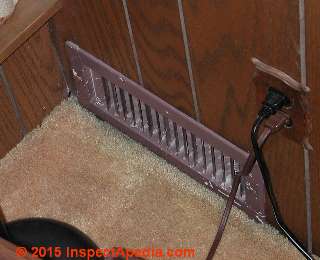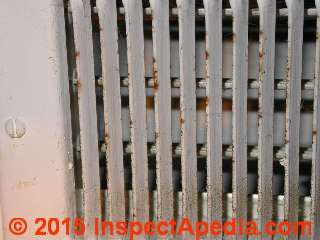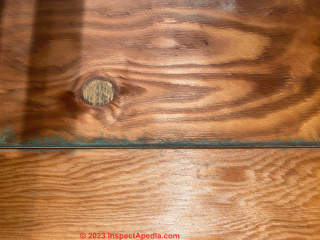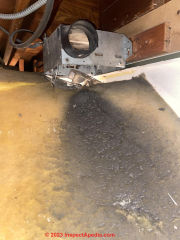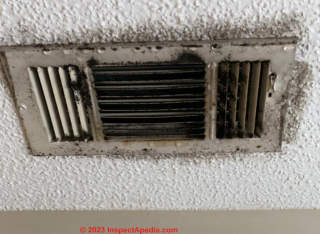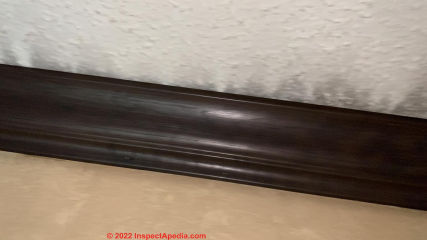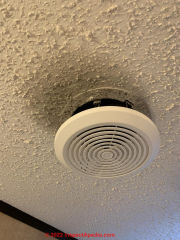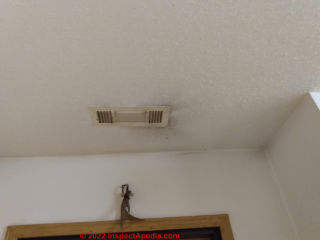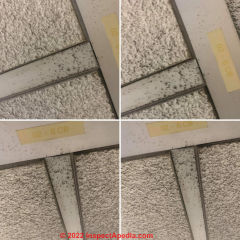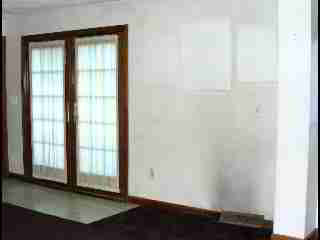 HVAC Dust or Soot Stains
HVAC Dust or Soot Stains
Diagnose Soot & Other Indoor Wall or Ceiling Stains Traced to
Heating or Air Conditioning Equipment
- POST a QUESTION or COMMENT about wall or ceiling stains that are traced to heating system problems
This article describes & diagnoses heating equipment as the cause of various interior wall and ceiling stains and explains how to recognize thermal tracking, thermal bridging stains, building air leaks, and building insulation defects.
Often these stains are mistaken for toxic indoor mold. When investigating a building for a mold problem, you can save mold test costs by learning how to recognize Stuff that is Not Mold or is only Harmless Mold but may be mistaken for more serious contamination.
InspectAPedia tolerates no conflicts of interest. We have no relationship with advertisers, products, or services discussed at this website.
Heating Systems & Other Sources of Dark Stains on Indoor Walls & Ceilings
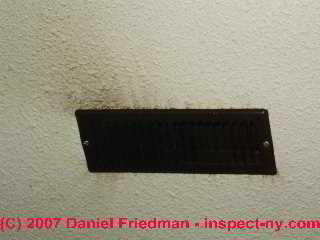 Our page top photo, sent by a reader, is a wonderful and unambiguous diagnostic photo.
Our page top photo, sent by a reader, is a wonderful and unambiguous diagnostic photo.
[Click to enlarge any image]
Here's what we see that strongly suggests that the primary source of dark stains in this room is a problematic heating system:
- Black sooty stains are darkest right over the warm air supply register at the floor in the photo's lower right corner©
- There are no stains or soot marks on the building walls where pictures have just been removed
- Black sooty stains are less dark on the wall surface as we move higher on the wall away from the heating register
- Black sooty stains on other walls in the room are much less noticeable
Dirt, Debris, Stains around Heating or Air Conditioning Air Registers
The soiling and "stains" around this ceiling supply register for warm air or air conditioned cool air show that the air system is dirty, has inadequate filtration, or is operating unsafely.
While mold or other problem particles could be present in this dirt or debris, if they are present they are coming from another source, not from this soiled area on the ceiling.
Here the debris deposited on the ceiling is in a common pattern where warm or cool air supply registers blow air across the ceiling surface (including from leaks around the perimeter of the register grille in this case.)
The stain pattern is from building air movement, it is not thermal tracking and it is not, by itself, an indicator of problem mold. A lab test of this debris for the presence of mold would not be justified based only on the observation of these stains, but it might be justified if there were other reasons to need to screen the building or its HVAC system for problem mold or other contaminants.
If you have frequent fireplace fires, cooking, or if you burn scented candles, if people smoke in your home, or if your oil-fired or gas-fired heating system is not working properly, the added soot particle load in the building air is not only a health concern (soot and potentially lead), it also will mark the building surfaces in this characteristic pattern.
We welcome more thermal tracking, soot tracking, air bypass leaks, and similar photos of indoor stains as well as text suggestions to expand this detail and would be glad to credit contributors.
Usually soot marks, thermal bridging, or thermal tracking stains appear, if at all, in the building interior locations discussed in the remaining sections of this article.
Normal House Dust Deposits at a Heating or Air Conditioning Air Register
Above the light gray dust deposits at this heating air supply register look normal - that is, house dust, comprised principally of fabric fibers and skin cells is usually light gray in colour in such deposits.
Only by examination in a forensic lab will we know for sure what's in the dust on this register, but unless there is reason to suspect that there are contaminants in the system such testing is normally not appropriate.
See MOLD / ENVIRONMENTAL EXPERT, HIRE ?- when to hire an expert
Below is a close-up example showing typical light dust deposits on an air supply register. The rust, depending on its cause and the source of moisture, might lead to a question of moisture, condensation, or perhaps mold contamination in the duct work of this building.
Reader Comments, Questions & Answers About The Article Above
Below you will find questions and answers previously posted on this page at its page bottom reader comment box.
Reader Q&A - also see RECOMMENDED ARTICLES & FAQs
On 2023-03-11 by InspectApedia Editor
@Lcc,
Possibly, there are greenish molds, and you've had moisture in the area.
THe amount - in square feet - is trivial and might be cleaned with any household cleaner and perhaps a small brush.
The question I'd have is: what's on the other side of that wood paneling?
On 2023-03-09 by Lcc
This green substance is in between the wood panels above where my bathroom vent lets out air into the ceiling, is this mold?
On 2023-03-11 by InspectApedia Editor - bathroom exhaust must be vented to the building exterior
@Sc,
Certainly blowing moist bathroom air into a building attic invites mold contamination and over a longer term, building damage.
Bath exhausts need to be vented to the building exterior.
On 2023-03-09 by Sc
Found out our apartment bathroom exhaust fan leads to nowhere, just the ceiling above us. Is there potential for mold in this?
On 2022-08-26 by InspectApedia-911 (mod) - black stains and water droplets on air register edges need investigation
@Deborah Moore,
Those deposits may be house dust or even soot from a heating system furnace, and it also looks as if there are water droplets on the register edges.
Those visual clues suggest that the HVAC system, air handler, and duct work may be very dirty, have not been maintained, need cleaning or repair/replacement (depending on the results of inspection), and that there is a risk of hidden mold contamination in the HVAC system as well as anywhere that condensate has dripped onto or wet ceiling drywall.
It would be appropriate to investigate further.
Watch out: First priority: if those ducts are supplying heated air from a gas-fueled furnace, there is a risk that the furnace and its burner are producing soot. If that's the case the heating system is very dangerous: when gas burners produce soot the immediate hazard is the production of dangerous, even fatal carbon monoxide.
MAKE CERTAIN, right away, that your apartment has working and properly located and tested smoke detectors AND carbon monoxide (CO) detectors.
And if there's apparent soot production, inform building management immediately, both orally and in writing that there is risk of dangerous or fatal carbon monoxide production requiring immediate inspection by a qualified, trained heating service technician.
On 2022-08-26 by Deborah Moore
Have black stuff running out of them. I was told that the black on the carpet and on the filter was not mold but what about the air vents?
On 2022-08-13 by InspectApedia-911 (mod)
@Dolores,
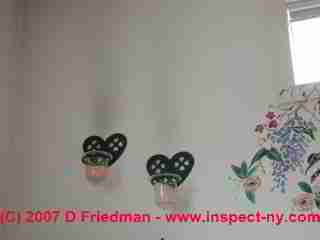 Well if your service technician is right, that means s/he didn't find an immediate life-safety hazard from your gas-fired heater.
Well if your service technician is right, that means s/he didn't find an immediate life-safety hazard from your gas-fired heater.
Certainly if the stains appeared AFTER your heater was turned OFF then that suggests the heater is not the cause of the staining.
Soot stains from burning scented candles are indeed found in buildings and are easy to identify as those stains will be concentrated in the area where the candles were burned.
Read details at
THERMAL TRACKING BRIDGING GHOSTING - home
and at
STAINS CANDLES FIREPLACE WOODSTOVE
Candle soot stains are principally from burning scented candles, not other candles, unless you're burning a lot of them.
And see my example photo here where you see candle stains on a wall.
In contrast, if your soot stains are more uniform and more extensive in the building, as shown in the thermal tracking article, they are not from burning candles.
On 2022-08-13 by Dolores
A tech from SJ Gas came out and said that the patterns were indicative of soot from burning candles.
My heater is off because we’re in the summer season. I’m still uncertain.
On 2022-08-10 by InspectApedia-911 (mod) - buildup of soot is very dangerous
@Dolores,
Watch out: what you describe is very dangerous.
Gas burning equipment that is producing soot is not working correctly and there's a possibility that it's producing dangerous or even fatal carbon monoxide gas.
Therefore you should be sure that you have working carbon monoxide detectors properly located, installed, and tested,
and the best course of action would be to turn the heater off immediately.
Then you need to have it inspected and repaired by a trained gas service technician. Keep us posted.
On 2022-08-09 by Dolores
We have natural gas and water heater and recently I’ve had a buildup of soot right over my floor ducts and now on my ceiling perimeter in all my rooms. I cleaned the ducts and thought that was the problem but the soot is covering my windows and curtains
On 2022-07-02 by InspectApedia (mod)
@Roz,
That sounds as if you need a careful and thorough on-site inspection of the HVAC system to find the problem such as mold in the ductwork, dirty ducts, or perhaps as you suggest, fan-disturbed dust that is not being adequately filtered by the system's air filter.
But FIRST be sure you have a new, clean air filter installed at the air handler.
On 2022-07-02 by Roz
When I use my central AC I get black soot in my upstairs bedroom. My two returns are in the ceiling with a ceiling fan between them which goes all night long. The blades of the fan are black on the upper sides and the carpet shows soot along the furniture directly below the ceiling fan.
This does not happen when my furnace is going only my AC. I feel this is related to the combination of the placement of AC returns and the placement of my ceiling fan directly in the middle going all night long.
On 2022-06-22 by InspectApedia (mod) - oil burner soot stains may indicate risk of puffback explosion
@Chris,
![]() Thanks for the photos and a helpful thermal tracking question.
Thanks for the photos and a helpful thermal tracking question.
There is not a shadow of a doubt that we are seeing thermal tracking deposits from a particle or soot source far greater than would occur from burning scented candles. The most likely cause is just what you suggest: an oil burner that was releasing soot into building air.
In our article STAINS CANDLES FIREPLACE WOODSTOVE
we illustrate in photos the sort of stains that occur from burning scented candles. In every instance the stains will occur above, not below, the candle location, and will be close to the candle location.
In your photo the black thermal tracking stains originate low on the wall, just above the heating baseboard - a common source of such stains because of the convection currents caused by warm air rising from the baseboard heaters.
In your photos the black thermal tracking stains occur throughout the room across the length of walls, from floor to ceiling, and on the ceiling as well.
The only way that such stains might be ascribed to use of scented candles is in my opinion one that is not at all realistic:
someone would have had to burn a great many such candles, to have placed them at floor level, to have distributed them uniformly around all of the walls of the room, and to have added additional scented candles at two or three heights up along the entire length of the walls and under the ceilings so as to produce an airborne soot level that was rather uniform in the room.
I estimate that one would have needed perhaps 100 or more such candles burned repeatedly or over long intervals. Frankly such a claim has no basis in the fact of the observations and stain patterns.
Watch out: it's common for a high volume of soot to be released repeatedly and over long intervals of inattention from an improperly operating or poorly adjusted oil burner. But the more serious risk is that continuing to use that oil burner without proper cleaning, tuning, adjustment, possibly needing also a chimney inspection, risks a dangerous puffback explosion.
See details at OIL BURNER SOOT & PUFFBACKS
On 2022-06-22 by Chris
Would construction in a basement where the boiler room and furnace were left unprotected and dirty lead to this happening on the walls and ceiling? My landlord was converting basement to duplex and failed an inspection. He's been doing construction for 2.5 years. Fully redoing basement.
Boiler and mechanical room was needing to be cleaned via inspectors. He is saying I did this with candles but I hardly used them at all.
On 2022-06-11 by InspectApedia-911 (mod) - round stain around register may be leak concern
@peter,
Do take a look at
THERMAL TRACKING BRIDGING GHOSTING - home
because those lines appear to follow ceiling joists.
The round stain around that supply register is suspicious: is this an A/C system supply register?
Has insulation been removed around it in the attic?
Have you checked the attic side of the drywall for condensate leaks or other leak stains and mold?
On 2022-06-11 by peter
Hi there, adding another image to the previous question.
On 2022-02-08 by Inspectapedia Com Moderator
@Austin Cade
What are we looking at? An air supply register?
Search InspectApedia.com using the on-page search box for GHOSTING THERMAL TRACKING STAINS to see details.
Those dark deposits are left by movement of air across the surface. It's not mold.
But stains along the horizontal trim (at a wall-floor or wall-ceiling juncture) are (house dust deposited by air moving over the surface) in that location and pattern do tell us that there is air leakage.
On 2022-02-08 by Austin Cade
Also this greyish spot kinda on the left side of my stove it’s an electric stove it’s been there awhile no growth in the area , Just want to come up with an answer on this spots as well hopefully.
Thanks in advance
Vent in bathroom , doesn’t look like mold to me I’m lost for things this could be tho.? Maybe I’m wrong tho but I hope not hopefully can get an answer.
Thanks in advance
On 2021-12-20 by Inspectapedia Com Moderator (mod)
@gwrosy,
A booming or explosive noise at the time of ignition of a gas furnace could be something as simple as thermal expansion of ductwork or if it truly is at the moment of ignition of the burner it's more likely to be an ignition of an accumulated amount of gas.
That could be from a gas leak or an improperly adjusted burner but in any event is quite unsafe.
That explosion risk combined with a production of dangerous or even fatal carbon monoxide gas by a malfunctioning gas heater is very dangerous.
That's why I warned you earlier to be sure that at the very least you had working and regularly tested smoke and carbon monoxide detectors throughout your home.
It's quite possible that a trained heating person at your home who saw the conditions that you describe would insist on turning off the system immediately for the safety of your family. He would red tag it meaning that it should not be turned on without repair or replacement.
I'm sorry as I know this is inconvenient but it's more convenient to be cold than to be fatally poisoned by carbon monoxide.
On 2021-12-20 by gwrosy
@Inspectapedia Com Moderator, also is is a conventional type gas furnace.
@Inspectapedia Com Moderator, it is a gas furnace on first floor townhome. it also makes abooming noise upon ignition. it is in a closet/its own room w gas hot water heater.
On 2021-12-20 by Inspectapedia Com Moderator (mod)
@Gw Rosy,
That looks like sort of dirt blowing out of an air supply registers.
Watch out: if you are heat is from gas fuel that's an extremely dangerous situation as sitting from the gas heater that's getting into the house are suggest both and improper flame and potentially fatal carbon monoxide poisoning. If it's an oil burner there still may be a failed heat exchanger and suit getting into the building Air Supply.
You need to have the heating system inspected and repaired or replaced.
You also may need duct cleaning.
Be sure that you have working smoke detectors and carbon monoxide detectors properly located, installed, and tested.
On 2021-12-20 by Gw Rosy
vent in kitchen in ceiling, what is this dark stuff? is it dangerous?
On 2021-10-22 by inspectapedia.com.moderator (mod)
@veganknitters,
Remove the mold
or remove moldy materials that can't be cleaned - and replace them
Inspect for hidden mold such as above the ceiling tiles and in nearby ductwork
Change / install new HVAC filters
Be sure water leaks are fixed
On 2021-10-22 by veganknitters
@veganknitters, number of staff complain regularly itchy eyes, cough, headaches etc. Air con regularly leaks and boiler blew several months ago with water tank evaporating into steam
@inspectapedia.com.moderator, this is one of a few ceiling vents in an office in middle of building. We are told vents cleaned every 3 months
On 2021-10-22 by inspectapedia.com.moderator (mod)
@Black mould/ soot/house dust?,
From that dotty pattern I think we're seeing a bit of mold growing on the surfaces - it'd be helpful to know what we're looking at: a ceiling, wall, or something else.
Total area is, of course, trivial but if there have been leaks or moisture traps it's worth further investigation.
On 2021-10-22 by Black mould/ soot/house dust?
Can anyone tell me if they think this could be black mould/ soot. Employer says it's house dust
On 2020-11-16 by (mod) - causes of patterns of dark stains or soot deposition on building walls and ceilings?
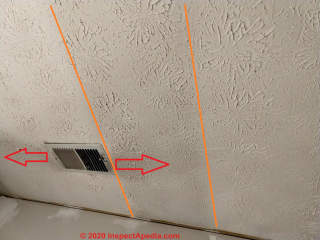 Rachel
Rachel
Thank you for a helpful question that I might re-phrase as
What are the causes of patterns of dark stains or soot deposition on building walls and ceilings?
at THERMAL TRACKING BRIDGING GHOSTING
You'll see that soot in that case is deposited along ceilings and walls where the presence or absence of insulation or wood framing members cause differences in
- surface temperature
- surface moisture
where more particles tend to bond to damp surfaces that often correlate with cooler surfaces indoors. That's because moisture in indoor air condenses out onto the surface at a faster or greater rate on cooler than on warm surfaces.
Besides moisture level and temperature differences in indoor surfaces soot or dust deposition is also affected by
- direction of air flow
- differences in surface texture
- variations other indoor air currents that affect the primary air flow direction such as out of an HVAC supply air register
In your photo we see quite clearly dark soot blowing parallel to the wall as directed by the bend in the individual louvers of the air supply register grille.
We also see dark lines in the ceiling that may mark an area of cooler ceiling.
The fact that the lines are so straight hints (I AM ONLY ABLE TO GUESS as I have no information about your building) that your photo may be showing a top floor ceiling below an attic AND there may be less, or disturbed, or leaky insulation above the darkened area.
Watch out: while a wood stove can indeed soot up a building interior, when we see black soot blowing out of the air register there are two common causes, listed in order of probability:
1. A heating furnace is unsafe, and operating improperly: producing soot and leaking combustion products out of the heat exchanger into the supply air plenum and thence through supply ducts into the building interior
Watch out: particularly if your furnace is gas fired there is a high risk of fatal carbon monoxide poisoning if the heater is producing soot.
Watch out: Be sure, in any case, that you have working and properly installed smoke and CO (Carbon Monoxide) detectors in your home, and get your heater inspected for safety and proper operation right away.
2. Return air pick-up of soot: Occasionally we find a soot or dirt source near cold air returns in the heating system or leaks in return air ducts that pick up soot or debris from other sources and blow it through the HVAC system.
For example a return air inlet that drew smoke out of your woodstove vent system might also blow it through the duct system.
On 2020-11-16 by Rachel
We just moved into a "new" house (new to us, built in 1979). The basement has an old cast iron wood stove (original to the house); the whole basement smelled strongly of smoke/creosote. I wet-vacced the carpet and we're replacing the wood panels with sheetrock, and the smoke smell is almost gone.
Near the registers on the ceiling, you can see the soot marks you describe (hopefully it's just from the fires and they are not related to the 14-year-old oil furnace)
. I was wondering if you had some idea why there would also be soot marks next to the register in a straight line across the ceiling between what I expect are the joists?
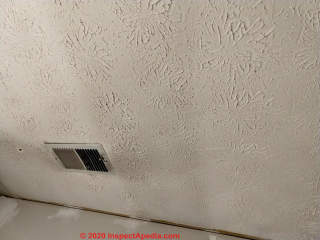
On 2020-10-28 - by (mod) - how to find the source of black debris on air filter after duct cleaning
BettyWhat is the material of your air ducts? If the duct interior is metal then those can be cleaned.
Air ducts made of flex duct or of fiberglass insulating board cannot be mechanically cleaned without risk of damage including shredding the duct insulation.
I can but guess, as I have no information about your HVAC system, that if your ducts were mechanically cleaned and damaged that could be a particle source.
Beyond that if no expert onsite can identify a soot or dust source and if that expert agrees that your filter material is an abnormal condition, then you might collect a tape sample of your filter dust to have analyzed by a forensic lab to identify the dominant particles.
That will usually point to the source.
Watch out: see my warning to Lori given below.
On 2020-10-28 by BettyGentile
I recently had my air ducts cleaned in my 17 year old townhouse Once cleaned my filters are turning black and I am noticing soot everywhere I have had the company come back and they cannot find the source of the soot What do I do
On 2019-12-14 - by (mod) -
Lori
Watch out: The immediate danger that we want to "rule out" is that there is an unsafe heating system in your home.
Risk: If your heat is by LP gas or natural gas, improper combustion can produce both soot and potentially fatal carbon monoxide gas.
Actions:
1. Alarms: Be sure that you have properly-installed, located, and tested smoke alarms (fire alarms) and CO (carbon monoxide) detector(s) in your home
2. Heater check: If the burner is noisy, smelly, sooty, rumbling or if this is your fuel, Have your heating service tech confirm that the heater is working properly, or fix it
Risk: if your heat is provided by an oil burner (and furnace or boiler) then improper combustion can produce soot and there is some risk of a "puffback explosion" from un-burned heating oil in the combustion chamber.
Actions: if the burner is noisy, smelly, sooty, then turn it off and have it serviced promptly.
On 2019-12-14 by Lori P.
I have converted a storage shed into a tiny house for me and my husband. we have been seeing black soot like settlement on our bedding, pillows and other areas located around our sleeping area.
i'm not sure what to do or think what is causing it. what do I do as in like a process of elimination to fix this issue that has been ongoing for the last 2 weeks straight. i'm scared that its toxic and will harm us if this keeps up plorip796@gmail.com
...
Continue reading at STAINS at HVAC REGISTERS or select a topic from the closely-related articles below, or see the complete ARTICLE INDEX.
Or see STAINS HVAC SOOT or DUST FAQs - questions & answers posted originally at this page
Or see these
Recommended Articles
- AIR LEAK DETECTION TOOLS
- AIR SEALING STRATEGIES
- AIRBORNE PARTICLE & MOLD LEVELS in DUCTWORK where we describe how to test HVAC systems and ductwork for mold.
- BLOWER LEAKS, RUST & MOLD
- IAQ DIAGNOSIS via THERMAL TRACKING STAINS
- MOLD / ENVIRONMENTAL EXPERT, HIRE ?- when to hire an expert
- MOLD on/in AIR DUCTS in HVAC SYSTEMS - photos of in-situ mold growth in or on actual ductwork
- MOLD on DUCT SUPPLY or RETURN REGISTERS - photos of in-situ mold growth on air supply and return openings and grilles.
- OIL BURNER SOOT & PUFFBACKS
- STAIN DIAGNOSIS on BUILDING INTERIORS - home
- STAINS CANDLES FIREPLACE WOODSTOVE
- STAINS DIAGNOSE IAQ PROBLEMS
- STAINS on INDOOR SURFACES, PHOTO GUIDE
- STAINS CANDLES FIREPLACE WOODSTOVE
- STAINS at HVAC REGISTERS
- STAINS on INDOOR SURFACES, PHOTO GUIDE
- THERMAL TRACKING BRIDGING GHOSTING - home
- WALL THERMAL TRACKING STAINS - examples of thermal tracking above a heating baseboard
Suggested citation for this web page
STAINS HVAC SOOT or DUST at InspectApedia.com - online encyclopedia of building & environmental inspection, testing, diagnosis, repair, & problem prevention advice.
Or see this
INDEX to RELATED ARTICLES: ARTICLE INDEX to BUILDING STAINS
Or use the SEARCH BOX found below to Ask a Question or Search InspectApedia
Ask a Question or Search InspectApedia
Questions & answers or comments about wall or ceiling stains that are traced to heating system problems.
Try the search box just below, or if you prefer, post a question or comment in the Comments box below and we will respond promptly.
Search the InspectApedia website
Note: appearance of your Comment below may be delayed: if your comment contains an image, photograph, web link, or text that looks to the software as if it might be a web link, your posting will appear after it has been approved by a moderator. Apologies for the delay.
Only one image can be added per comment but you can post as many comments, and therefore images, as you like.
You will not receive a notification when a response to your question has been posted.
Please bookmark this page to make it easy for you to check back for our response.
Our Comment Box is provided by Countable Web Productions countable.ca
Citations & References
In addition to any citations in the article above, a full list is available on request.
- Thanks to Alan Carson, Carson Dunlop, Associates, Toronto, for technical critique and content suggestions regarding thermal tracking.
- Our recommended books about building & mechanical systems design, inspection, problem diagnosis, and repair, and about indoor environment and IAQ testing, diagnosis, and cleanup are at the InspectAPedia Bookstore. Also see our Book Reviews - InspectAPedia.
- In addition to citations & references found in this article, see the research citations given at the end of the related articles found at our suggested
CONTINUE READING or RECOMMENDED ARTICLES.
- Carson, Dunlop & Associates Ltd., 120 Carlton Street Suite 407, Toronto ON M5A 4K2. Tel: (416) 964-9415 1-800-268-7070 Email: info@carsondunlop.com. Alan Carson is a past president of ASHI, the American Society of Home Inspectors.
Thanks to Alan Carson and Bob Dunlop, for permission for InspectAPedia to use text excerpts from The HOME REFERENCE BOOK - the Encyclopedia of Homes and to use illustrations from The ILLUSTRATED HOME .
Carson Dunlop Associates provides extensive home inspection education and report writing material. In gratitude we provide links to tsome Carson Dunlop Associates products and services.


